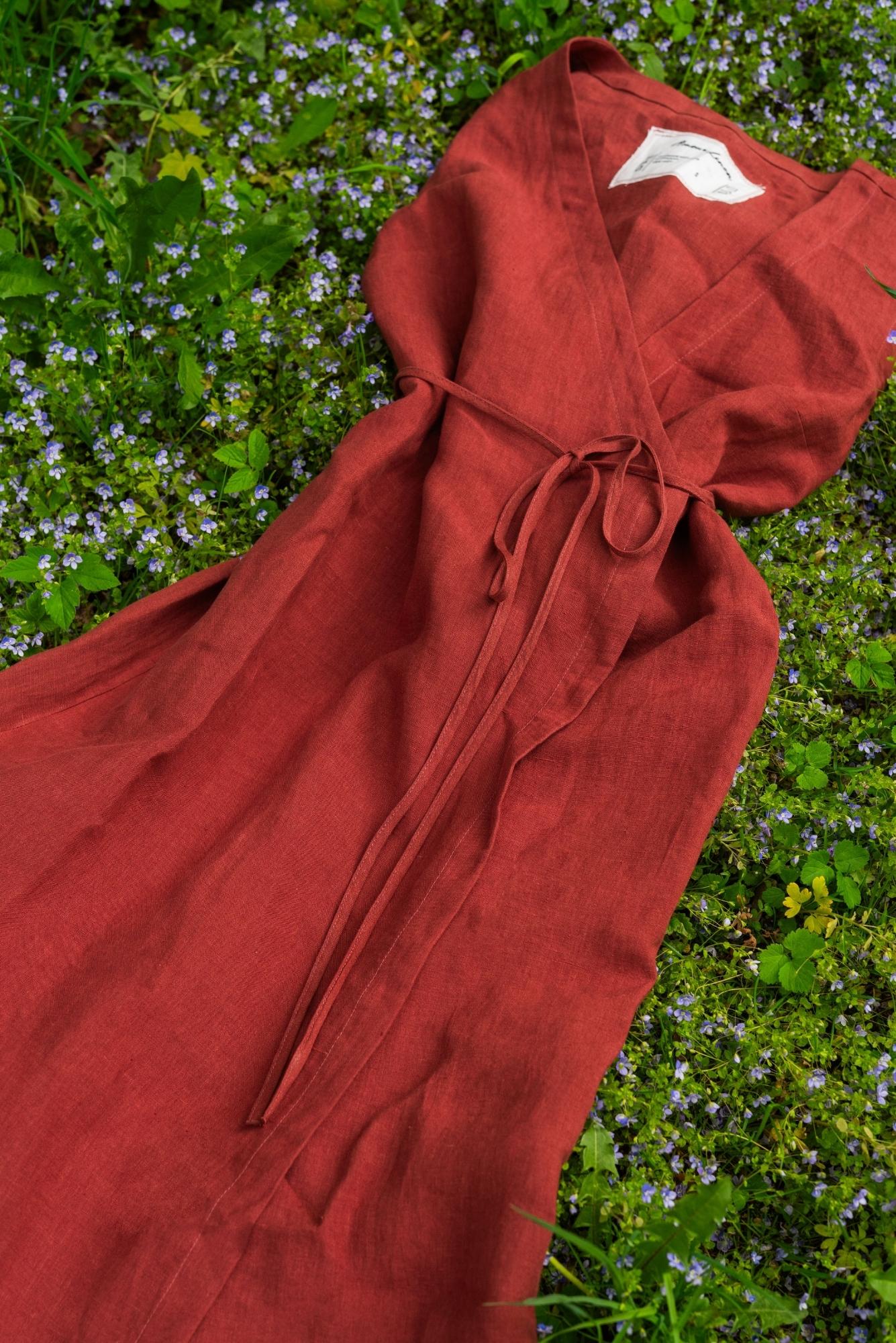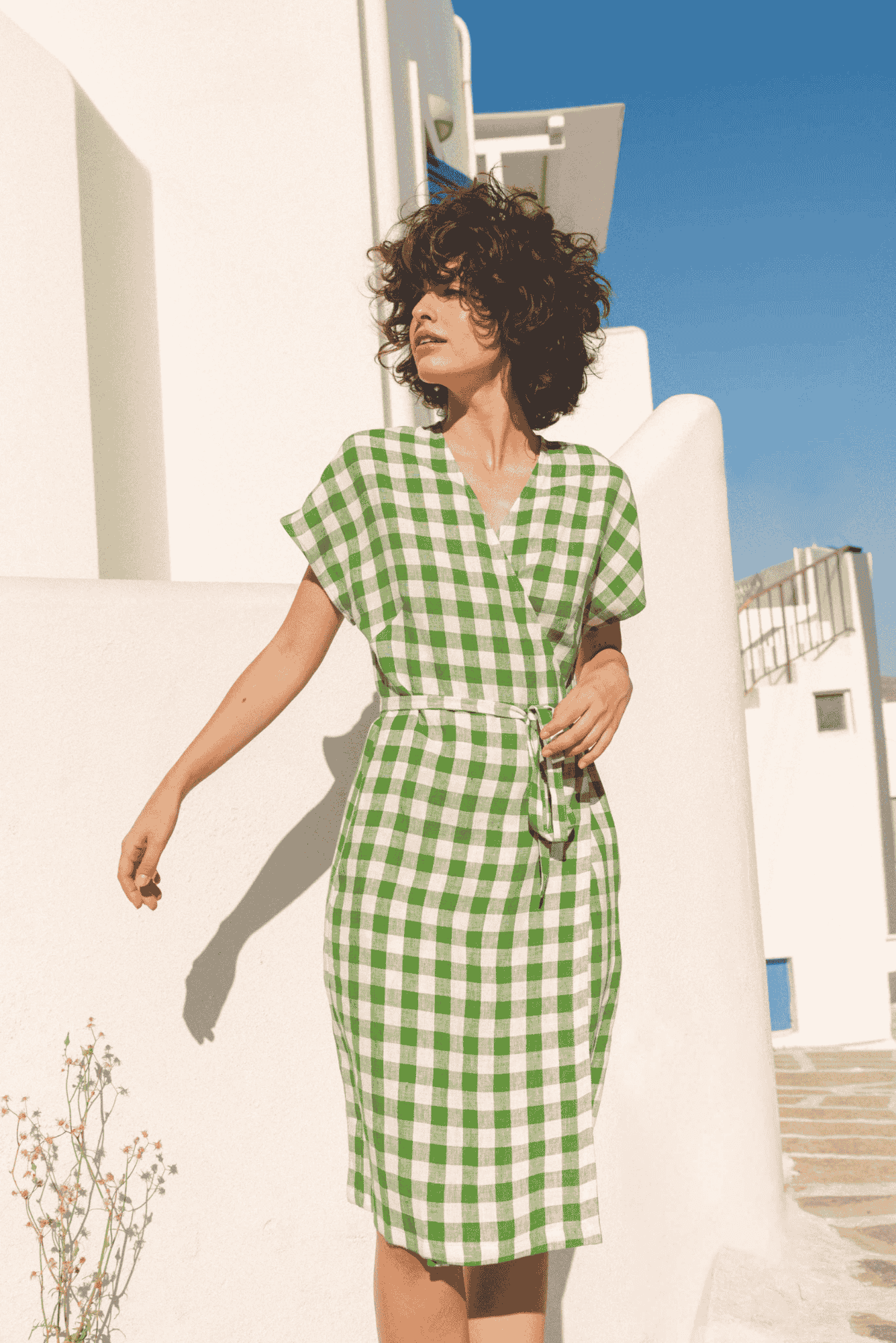Linen is one of the oldest and most loved natural fabrics. That said, it also has a unique personality. It wrinkles, softens, and moves in ways that make each piece feel lived-in and real. And while some creases are part of the charm, there are moments when a smooth finish makes all the difference.
If you enjoy linen’s ease but want to care for it with confidence, this guide is for you. We’ll show you how to iron linen properly without losing the relaxed look that makes linen so appealing.
Should you iron linen at all?
Linen has a relaxed look by nature. It's one of the few fabrics that actually wears its wrinkles well - soft creases add character, showing off the texture and movement that make linen so special. That’s why many people choose not to iron it at all.
However, there are moments when wearing a perfectly ironed linen item makes the most sense. Maybe you're heading to a formal event, or you just want to feel more put-together. In those cases, ironing can help your linen garments look crisp without losing their charm - as long as it’s done gently.
That said, if you’re not a fan of ironing, the good news is you don’t always have to. With the right care, many linen pieces - especially those designed with a looser fit - look fresh straight off the line.

Tools you’ll need to iron your linen
For those times when you choose to iron your beloved linen pieces,, let’s get you fully equipped! No worries, no big investments needed – you’ve probably already own all the tools at home.
As linen responds best to steady heat, a bit of moisture, and a gentle hand, consider keeping the following items nearby:
1. Steam iron or a quality steamer
Use a reliable tool with a strong steam function and a high-heat setting that’s safe for linen. Whether you prefer a traditional iron or a handheld steamer, steady steam and consistent heat will help smooth out wrinkles without damaging the fabric.
2. Spray bottle with water
Linen irons best when slightly damp. A quick mist makes all the difference, softening the fibers and making wrinkles easier to smooth out. For best results, use clean, cool water and avoid soaking the fabric. A light and even spray is enough.
3. Pressing cloth
A clean cotton cloth placed between the iron and the fabric helps protect delicate or darker items from shine or scorching.
4. Stable ironing board or flat surface
Make sure it’s smooth, padded, and heat-safe. You want enough space to spread the garment out fully.
How to iron linen properly: a step-by-step guide
Ironing linen doesn’t have to be intimidating. The key is to start when the fabric is slightly damp, use steady heat, and move with care.
Here's how to do it without damaging the fabric (or, let’s be honest for one moment, losing your patience).
1. S tart when it’s damp
Your linen is fresh from the wash and still slightly damp? It’s perfect for ironing! If your linen gems are already dry, give them a light mist with water and wait a minute or two.
2. Turn garments inside out
Doing so helps avoid shine, especially on darker colors or structured pieces.
3. Set your iron to linen or high heat
Linen needs steady heat, but not for too long in one spot. If your iron has a steam function, turn it on.
4. Use a pressing cloth if needed
Place a thin cotton cloth between the iron and the fabric to protect more delicate pieces.
5. Work in sections
Begin with details like collars, cuffs, waistbands, or seams. Then move on to larger areas, always ironing along the grain of the fabric.
6. Keep the iron moving
Smooth, continuous strokes work best. Avoid pressing down too hard or holding the iron still.
7. Hang or lay flat immediately
Let the garment cool and dry fully before wearing or folding to keep its shape.
Should you iron your linen damp or dry?
Always choose damp. Linen fibers relax when they’re slightly moist, making wrinkles easier to smooth out.
Dry linen, on the other hand, tends to resist the iron and increases the risk of scorching. A quick spritz is often all it takes to bring the fabric back to a pressable state.
Caring for different linen pieces
Linen behaves a little differently depending on the shape and structure of the item. A flowing dress doesn’t need the same approach as a tailored shirt or a flat sheet. Here’s how to iron each piece with care, without overthinking it.

Linen dresses
Linen dresses often feature different details: zippers, pleats, belts, and seams, all of which can make them a little more time-consuming to iron. But with a gentle approach, it’s easy to keep them looking elegant.
First off, unbutton or unzip the dress and turn it inside out. Start ironing from the top: shoulders, neckline, and seams. Move on to the sleeves and bodice, then finish with the skirt. If your dress has pleats or a belt, take your time, smooth each part gently without pulling.
For lightweight or airy designs, place a clean towel underneath while ironing to avoid pressing in sharp creases. Once you're done, hang the dress to cool naturally.

Linen shirts, tops and blouses
As they’re more structured and often worn close to the body, linen shirts and blouses tend to look best with a bit more precision. A neatly pressed collar or cuff can make the whole piece feel fresh.
Begin with the collar and cuffs as these areas usually need the most attention. Move on to the sleeves, then the shoulders, and finally the body of the shirt or blouse. Always iron along the fabric grain, and use a pressing cloth if the fabric is thin or dark to avoid shine.
To maintain a soft drape, avoid over-pressing and let the blouse cool on a hanger before wearing.

Linen pants and skirts
Linen pants and skirts are often made from thicker linen or feature details like pleats, buttons, or darts, which need a bit more care around seams. But the good news is that they're usually the easiest to lay flat and iron.
Turn them inside out and begin with the waistband and pockets. For pants, press along the seams, then fold each leg if you want a sharp crease and iron along the fold with steam.
For skirts, work your way down from the waistband, smoothing as you go. If the skirt is gathered or pleated, press lightly and avoid flattening the fabric.

Linen bedding
Because of its size, linen bedding can feel intimidating to iron. But actually it’s the most forgiving type of linen. A few gentle creases only add to its charm, especially when the fabric is clean and smooth to the touch.
Linen bedding is best ironed while still slightly damp. Start with pillowcases, then move on to duvet covers and sheets. Use a large, flat surface and fold bedding in half if needed to fit your ironing board. Keep the iron moving, and don’t worry too much about perfection; linen bedding looks beautiful with a few soft creases.
If you’d rather skip the iron altogether, simply smooth the fabric by hand after line-drying and store it folded flat.
Steam vs. iron – what works best?
Both steamers and irons can smooth out linen, but they work a little differently. Which one you choose depends on the look you're going for.
Steamers are quick, gentle, and ideal for lightweight linen pieces like dresses or blouses. They're especially useful when you're short on time or don’t want to deal with a full ironing setup. Steaming is also a great option if you're trying to avoid pressing lines or shine on darker fabrics.
Irons, on the other hand, are better for achieving a more structured finish. If you're pressing collars, cuffs, waistbands, or want a crisp crease in a pair of pants, a steam iron with a high-heat setting will give you more control.
If you love the clean look but want to keep things simple, a steamer can handle most day-to-day needs. But when you want that polished finish, especially for tailored pieces, an iron is still the better tool.
Wrinkles You Can (and Should) Embrace
One of the best things about linen? It doesn't need to look perfect to look good. In fact, a few soft wrinkles are part of its charm. They give the fabric movement, texture, and that lightweight feel linen lovers appreciate.
Trying to press out every crease isn’t always worth the time, or the stress. If your garment is clean, smells fresh, and has been hung or folded neatly, it’s often ready to wear without touching the iron. That’s especially true for looser styles like wrap dresses, oversized shirts, or anything meant to drape naturally.
At AmourLinen, we design with that ease in mind. Many of our linen dresses look beautiful as they are, no ironing necessary.
And if a few wrinkles show up during the day? They’re just a part of your wonderful story!





Leave a comment
This site is protected by hCaptcha and the hCaptcha Privacy Policy and Terms of Service apply.